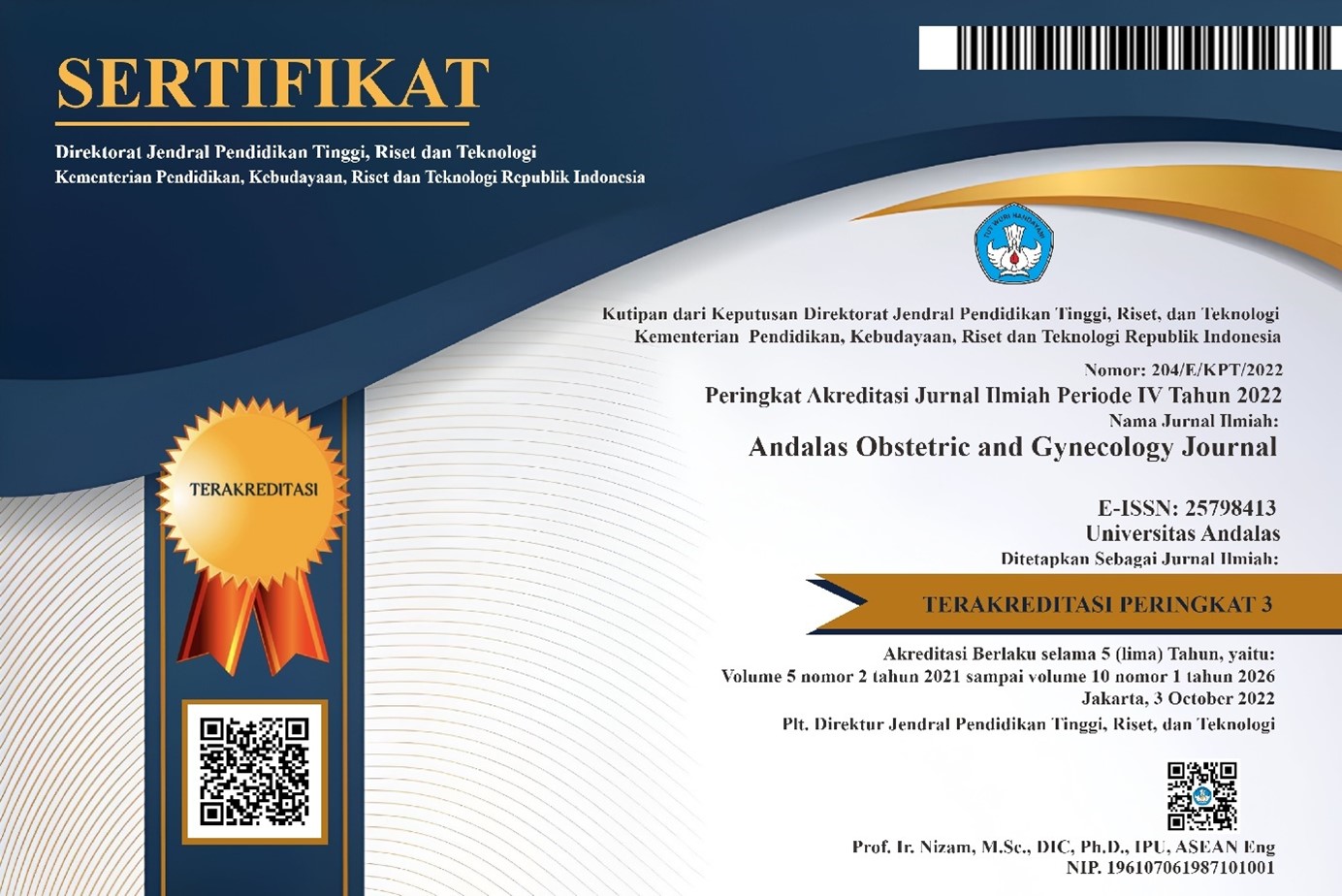Correlation of Colony Lactobacillus spp. with The Incident of Overactive Bladder with OBSS Score at Pauh Primary Health Center Padang
DOI:
https://doi.org/10.25077/aoj.5.1.56-62.2021Abstract
Background : Overactive bladder (OAB) is a group of urgent symptoms, with or without urgent incontinence. Research shows that some Lactobacillus spp. can be a sign of a women bladder’s good health; and found a decrease number of Lactobacillus spp. in patients with OAB. This study aims to assess the correlation of Lactobacillus spp. colony with OAB using the OABSS score at Pauh Primary Health Center, Padang.
Method : This research is an analytic study with a cross sectional comparative design. The research was conducted from December 2019 to February 2020 at Pauh Primary Health Center. All women aged 20-40 years who came to Pauh Primary Health Center during the study period were included in the study. Pregnant women, having pelvic abnormalities and a history of other urinary tract diseases or having a history of hypertension and diabetes mellitus were excluded in the study. Numerical data are presented in the form of central tendency. Bivariate analysis was performed using the t-independent test if the data distribution was normal and the Kolmogorov-Smirnov test if the distribution of the data was not normally distributed.
Result: There were 42 samples consisting of 21 OAB respondents and 21 normal respondents. The age of the respondents in the OAB group was 28 ± 6.8 years, while the normal group was 32 ± 7.3 years (p> 0.05). The number of Lactobacillus spp colonies in the normal group was higher than the OAB group, namely 16,389,670 ± 74,380,427.9 CU / ml compared to 15,229,634 ± 67,553,932.9 CU / ml (p> 0.05).
Conclusion: There was no correlation between the number of Lactobacillus Spp colonies and the incidence of Overactive Bladder. It is necessary to do further research regarding other risk factors associated with the incidence of OAB and the causes of the decrease number of Lactobacillus spp colonies in OAB patients and the presence of other microorganisms, especially pathogenic microorganisms.
Â
Keywords: overactive bladder, Lactobacillus, OABSS scoreReferences
Junizaf. Book Teach Gynecology. 2003;7-10.
Stewart W, Van Rooyen JB, CundiffGW, et al. Prevalenceand burden of overactive bladder in the United States. Worldd J Urol. 2003; 20 (6): 327- 36.
Irwin DE, Milsom I, Hunskaar S, et al. Population-based survey of urinary incontinence, overactive bladder, and other lower urinary tract symptoms in five countries: Result of the EPIC study. Eur Urol. 2006; 50: 1306-15pp.
Tirtayasa PMW, RahardjoHE. A survey on the management of overactive bladder by Indonesian urologists. Med J Indonesia. 2015; 24 (2): 91-6.
Pearce MM, Hilt EE, Rosenfeld AB, et al. The female urinary microbiome: a comparison of women with and without urgency urinary incontinence. MBio. 2014; 5: e01283–314.
Thomas-White K, Brady M, Wolfe AJ, et al. The bladder is not sterile: History and current discoveries on the urinary microbiome. CurrBladderDysfunct Rep. 2016; 11: 18–24.
Pearce MM, Zilliox MJ, Rosenfeld AB, et al. The female urinary microbiome in urgency urinary incontinence. Am J Obstet Gynecol. 2015; 213: 347.e1–347.e11
Khasriya R, Sathiananthamoorthy S, Ismail S, et al. Spectrum of bacterial colonization associated with urothelial cells from patients with chronic lowerurinary tract symptoms. J Clin Microbio. 2013; 51: 2054–62.
Karstens L, Asquith M, Davin S, et al. Does the urinary microbiomeplay a rolein urgency urinary incontinence and its severity? rontCell Infect Microbiol.2016; 6: 78.
Nelson DE, Dong Q, Van Der Pol B, et al. Bacterial Communities of the coronal sulcus and distal urethra of adolescent males. PLoS One. 2012; 7: e36298.
Ayres J. Cooperative Microbial Tolerance Behaviors in Host-Microbiota Mutualism. Cell. 2016; 165: 1323–31.
Le PT, Pearce MM, Zhang S, Campbell EM, ok CS, Mueller ER, Brincat CA, Wolfe AJ, Brubaker L. IL22 regulates human urothelial cell sensory and innate functions through modulation of the acetylcholine response, immunoregulatory cytokines and antimicrobial peptides: an assessment of an in vitro model. PLoSOne. 2014; 9: e111375.
Downloads
Published
Issue
Section
License
Copyright (c) 2021 Andalas Obstetrics And Gynecology Journal

This work is licensed under a Creative Commons Attribution 4.0 International License.
Copyright
Authors who publish with this journal agree to the following terms:
- Authors retain the copyright of published articles and grant the journal right of first publication with the work simultaneously licensed under a Creative Commons Attribution 4.0 International License that allows others to share the work with an acknowledgment of the work's authorship and initial publication in this journal.
- Authors are able to enter into separate, additional contractual arrangements for the non-exclusive distribution of the journal's published version of the work (e.g., post it to an institutional repository or publish it in a book), with an acknowledgment of its initial publication in this journal.
- Authors are permitted and encouraged to post their work online (e.g., in institutional repositories or on their website) prior to and during the submission process, as it can lead to productive exchanges, as well as earlier and greater citation of published work (See The Effect of Open Access).
License:
Andalas Obstetrics and Gynecology Journal (AOJ) is published under the terms of the Creative Commons Attribution 4.0 International License. This license permits anyone to copy and redistribute this material in any form or format, compose, modify, and make derivatives of this material for any purpose, including commercial purposes, as long as they credit the author for the original work.







